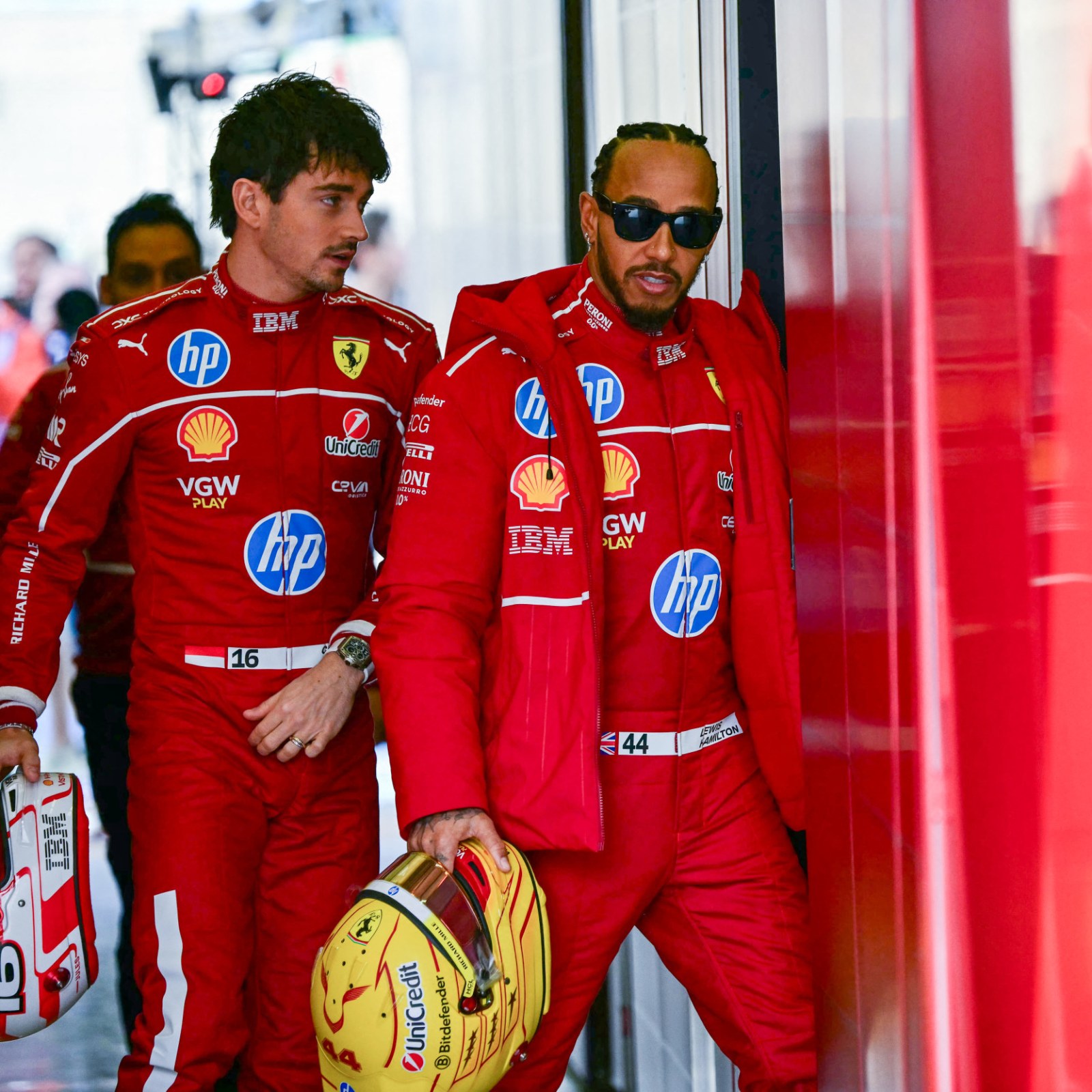Charles Leclerc’s pole lap in Budapest didn’t just surprise McLaren—it stunned Ferrari. At a circuit he once called cursed, Leclerc pulled out a 1:15.372 masterstroke that displaced both Piastri and Norris.
But while the cameras zoomed in on celebration, the other side of the garage stood still.
Lewis Hamilton had already packed up, eliminated in Q2, his tone quiet, resigned. No technical complaint, no radio fury—just a slow fade.

It wasn’t just a bad qualifying. It was the final beat in a weekend that had been out of rhythm from the start. In FP1, after just one exploratory lap, Hamilton told engineer Riccardo Adami the car didn’t feel right. Not a request. Not a balance note. Just discomfort. And Adami’s response? A flat “okay.” No probing, no recalibration. Just silence. For a driver like Hamilton, that silence is deafening. It doesn’t just reflect a setup issue—it reflects emotional misalignment.
In contrast, Leclerc’s connection with the car was electric. As the track cooled and grip peaked, he stitched together a lap that showed not raw aggression, but rhythm. The SF25 came alive for him—turn-in, throttle pickup, corner balance—all singing in harmony. It was a car speaking Leclerc’s language.
Hamilton’s SF25, meanwhile, felt like it had forgotten his dialect entirely. His style—smooth, incremental, intuitive—clashed with the chassis designed to reward early rotation and aggressive braking. It’s not a matter of preference. It’s architecture. And when architecture doesn’t fit the driver, confidence erodes. In Budapest, Hamilton wasn’t just out of sync. He was out of trust.
That trust breakdown showed up in the data too. Ferrari’s new rear suspension package, designed to stabilize the car under high-speed load, matched Leclerc’s driving profile to near perfection. But for Hamilton, it broke the feedback loop. His corrections came late—not because of overdriving, but because of hesitation. The car responded before he committed. And that’s a trust issue, not a telemetry glitch.
Inside Ferrari, that disconnect is becoming systemic. Setup requests tell the story. Leclerc asked for a revised anti-roll bar setting—it was implemented immediately. Hamilton requested a softer diff map to help with exit traction in sector 3. It was trialed, then shelved. One driver’s feedback leads to change. The other’s becomes a data footnote.

Worse still, engineers are reportedly beginning to default to Leclerc’s telemetry for baseline setup design. Not out of favoritism, but convenience. His style produces replicable results. Hamilton’s nuanced feedback—phrases like “the rear feels anxious”—requires interpretation. And in a high-pressure environment like Ferrari, interpretation can feel like guesswork. So they lean on what’s clear.
That clarity has a cost. Slowly but steadily, Hamilton is becoming Ferrari’s variable—respected, but not trusted as the performance anchor. His lap times aren’t the issue. His integration is. And that’s where the real damage lies. Because in Formula 1, when one driver starts defining the car’s evolution, the other isn’t just adapting. He’s chasing.
Even Hamilton’s most trusted tools are being marginalized. Brake Map 7, a setup he once used to stabilize rear instability in Baku, quietly returned in Budapest. Ferrari didn’t acknowledge it in the post-session debrief. But it was there in the overlays, a signal that Hamilton was searching for confidence his engineer wasn’t offering.
This emotional drift has precedent. At Mercedes, Hamilton’s bond with Peter Bonnington was legendary—built on years of mutual understanding. At Ferrari, his voice is now filtered through Adami, a veteran but not a translator. Their radio exchanges have grown shorter. The empathy is missing. And when feedback doesn’t get a response, drivers stop offering it fully.
Internally, Ferrari’s engineering team is fracturing into two quiet camps—those designing around Leclerc’s sharp, aggressive profile, and those struggling to adapt Hamilton’s layered, feel-based style into numbers. It’s not open conflict. It’s erosion. And erosion, left unchecked, becomes identity.
From the outside, Ferrari still claims dual-driver development. But the signals are clearer than ever: Leclerc defines the car. Hamilton interprets it. That imbalance isn’t malicious—it’s inertia. But it carries strategic consequences. Especially in a title fight this tight.
McLaren, unified in rhythm, continues to develop both drivers in lockstep. Red Bull, struggling in patches, knows they need only outlast Ferrari’s instability. And Mercedes—watching quietly—may be preparing for Hamilton’s early return if this spiral continues. There are whispers of exit clauses. Nothing public, but enough to change tone in the paddock.

Budapest revealed more than lap times. It exposed fault lines. A pole lap for Leclerc. A 12th place for Hamilton. One driver syncing with his car. Another circling, searching for language it no longer speaks. And in a team that promised balance, that’s more than a setup issue. It’s a philosophical crisis.
Because this was never just about speed. Hamilton was brought in to realign Ferrari’s culture. To prepare for the 2026 regulations not with horsepower, but with leadership. His value lies in cohesion—in knowing how to harmonize departments, how to bridge feel and function. But if Ferrari won’t build around that strength, they reduce him to a symbolic presence.
The real danger? That this becomes another chapter in F1’s long book of dual-leader projects gone quiet. Like Vettel in 2020, when Ferrari shifted chassis evolution around Leclerc. Like Ricciardo at Red Bull, when Verstappen’s data took over development. Like Bottas at Mercedes, frozen out by a car increasingly shaped by Hamilton’s needs. In each case, the second voice got quieter, until it wasn’t part of the conversation.
Now, in 2025, Ferrari risks doing the same—this time with the wrong driver. Because Hamilton, for all his history and titles, isn’t demanding dominance. He’s asking to be heard. To lead, not just follow.
Leclerc is fast, integrated, and rightfully celebrated. But if Ferrari lets the car evolve exclusively toward him, they risk limiting its future. Not just for this year, but for 2026, where adaptability will define success. And Hamilton, uniquely, offers that adaptability—if they build with him, not just around him.
As Monza looms, the stakes are rising. The Tifosi will see the lap times, but they’ll feel the chemistry. And if Budapest was a quiet fracture, Monza could be a reckoning. Because trust, once broken, doesn’t return through data. It returns through belief.
Ferrari has to decide: Will they recalibrate and harness both philosophies, or keep drifting toward a singular identity? The answer won’t just shape their title hopes. It will define who they are as a team—and who they’re building for.
Full Video:





